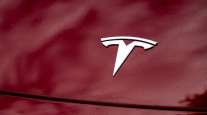Bloomberg News
Tesla Swaps Year-Away Robotaxis for Year-Away Humanoid Robot

[Stay on top of transportation news: Get TTNews in your inbox.]
More than two years after touting plans to turn Tesla Inc. vehicles into robotaxis that have yet to materialize, Elon Musk held another highly technical event about autonomous driving development.
Robots on wheels are still a ways off, it seems, so he’s now plugging one on legs.
After roughly 90 minutes of engineering talk spanning neural networks, computer vision and data-labeling, Tesla’s chief executive officer ceded the stage during the company’s AI Day event to a human dressed and walking like a robot.
“We think we’ll probably have a prototype sometime next year that basically looks like this,” Musk said late Aug. 19, shortly after a person in a skin-tight white suit and black helmet performed a techno-Fred Astaire dance sequence.
Join us to build the future of AI → https://t.co/Gdd4MNet6q pic.twitter.com/86cXMVnJ59 — Tesla (@Tesla) August 20, 2021
Musk, 50, was more measured than he was during Tesla’s Autonomy Day in April 2019, refraining from any predictions about when the company’s vehicles will be able to go driverless. He also avoided the subject of the National Highway Traffic Safety Administration opening a formal defect investigation into Tesla Autopilot after almost a dozen collisions at crash scenes involving first-responder vehicles.
“The Bot reveal excitement will likely provide a near-term boost to shares,” Colin Langan, a Wells Fargo Securities analyst who rates Tesla the equivalent of a hold, wrote in a report. He cautioned the NHTSA probe and other issues likely will be “more relevant mid-term drivers.”
Tesla shares rose as much as 0.9% before the start of regular trading. The stock has dropped 4.6% this year.
Open to Licensing
Over the course of several presentations, Tesla highlighted progress it’s making on semiconductors designed in-house to power the brains used for its advanced driver-assistance features. Musk said the company would consider licensing its technology to other carmakers.
The D1 chip shown off during the event is crucial to Dojo, a previously touted supercomputer Tesla plans to use for simulation and video training. Musk said the company should have Dojo operating next year and tweeted about its capabilities after the event.
While rivals such as Aurora, Cruise, Waymo and Zoox are using a blend of cameras, lidar and radar sensors to pursue autonomy, Tesla is working on a purely “vision”-based system using eight cameras mounted into its vehicles to process what its engineers refer to a real-time, three-dimensional “vector space.”
Making Progress
Andrej Karpathy, Tesla’s director of AI, narrated a series of videos showing the company’s cars negotiating traffic and parking lots. Other engineers talked about Tesla’s 1,000 person-strong data-labeling team and simulation capabilities.
“It seems like the multicamera feature to capture the bird’s-eye view has improved,” said Ijteba Ali Agha, a portfolio manager at HBL Bank Ltd. in London, who stayed up past 2 a.m. to watch the presentation. “A lot of tech stuff Andrej is explaining — it seems that the company is advancing.”
Tesla has told authorities Autopilot is still a Level 2 driver-assistance system, meaning it still needs constant human supervision.
Optimus
Much of the question-and-answer session that capped the event focused on the Tesla Bot — code named Optimus — that will feature the cameras used for Autopilot in its humanoid head and a “Full Self-Driving” computer in the torso.
“It’s intended to be friendly, of course, and to navigate through a world built for humans and eliminate dangerous, repetitive and boring tasks,” Musk said. He cited picking up a bolt and attaching it to a car with a wrench and going to the store to pick up groceries as examples.
In the future, “physical work will be a choice,” he said. “If you want to do it, you can, but you won’t need to do it.”
Musk has a history of unveiling prototypes and selling a vision long before actual products are ready. In November 2017, Tesla unveiled a Semi truck that has yet to go into production. It’s been pushed back to next year at the earliest, due in part to challenges making larger battery cells promoted in September of last year.
“Elon has a big vision,” said analyst Gene Munster of Loup Ventures. “For investors, the Tesla Bot is something new that they can dream about.”
Want more news? Listen to today's daily briefing below or go here for more info:




